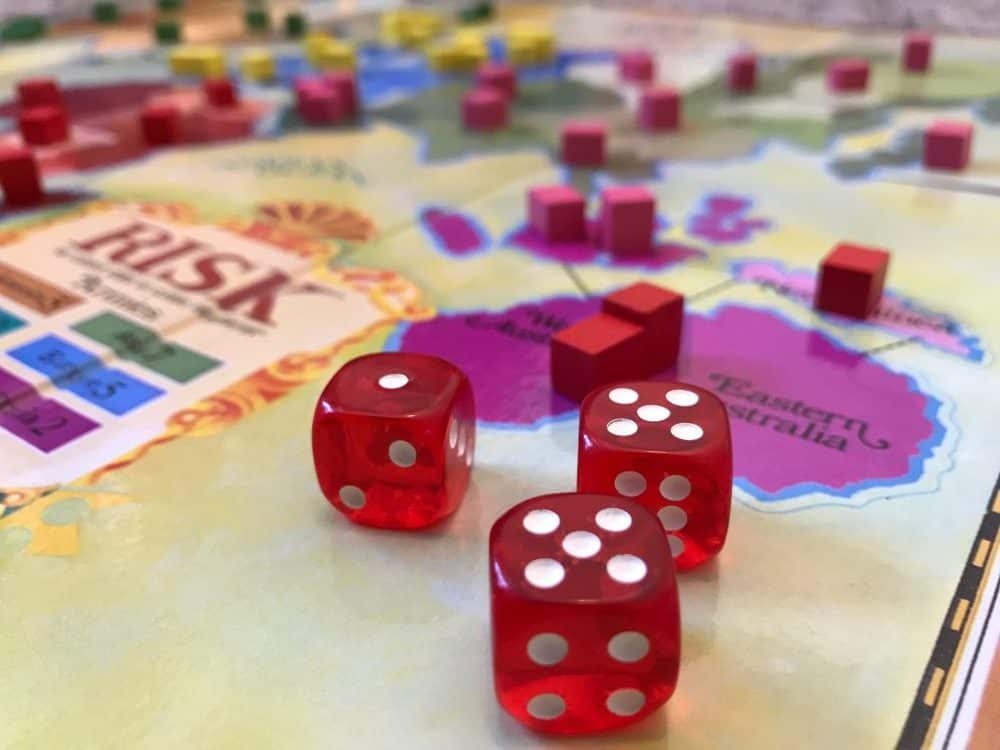
An “area control game” is one where players attempt to gain dominion of a specific region on a board to acquire an associated special ability or bonus. This may look a little different depending on the game. The general idea, however, is that by occupying/controlling an area a player receives an ability or bonus that other players won’t receive because they don’t control or own that area. The gained ability may affect gameplay or it may simply be some sort of bonus at the end of the game.
How Does An Area Control Game Work?
Players in the game are generally competing to gain control of desirable areas of the board. It is typically accomplished by using or spending meeples, coins, jewels or other games pieces to take possession of the area. The competition for regions is usually some sort of battling with other players through fighting to the death to gain control of the preferred space.
The conquered area might be permanently possessed, or may be obtained on the next player’s turn. The regions are fought over throughout the game, with one player eventually gaining the most—or all of the zones to finish the game. Defeated players and their associated pieces are removed once the conquering player has taken possession of the area. This can often come at a great cost to the conqueror. The conqueror could lose pieces while fighting to overtake the region creating a vulnerability through reduced numbers. Additionally, by occupying more areas with a limited number of pieces the victor could become vulnerable to another player in future battles.
Area Control As A Game Mechanic
Area control is a game mechanic that is employed by game makers to compel player interaction and conflict. It introduces strategy into a game by forcing players to choose where, when, and how to take control of an area; or decide if they want to attempt at all. With this element of gameplay, players must prioritize which of their pieces to use and when. Once a conflict is initiated between players, typically the player that has the majority of pieces in an area takes control of it.
Certain sections of a board within an area control game can be objectively more desirous than others. Because of this, players naturally gravitate toward the more favorable regions. Often, there are places within the game which are less desirous or relatively worthless all together. This causes a scarcity between players and limits the regions a player can occupy in order to win the game. Naturally this creates more reason for player interaction throughout the game.
Many games like Risk and Small World (discussed below) use the area control mechanic as the main mechanic of the game. Virtually every action completed within the game has to do with gaining control of an area. Some games have area control components, but other game elements are more central to the end goal of gameplay. This may cause some games to be categorized as another type of game instead of an area control game.
What Makes Area Control Different Than Other Types of Games?
The defining characteristic of area control games is that the players are required to occupy space to gain some sort of benefit to advance them toward victory. They cannot win without it.
Other games, however, often require less player interaction (though not always), or none at all. Players in these types of games can “play their own game” and win without thwarting others. The players basically play a solitary game in which they are avoiding interaction with other players. Even in games where substantial player interaction exists, if players are not competing to occupy space the game is not defined as an area control game. The main mechanic would not involve attempting to occupy space, or to remove another player from a space, because there isn’t a board or benefit in obtaining regions.
Popular Area Control Games
There are far too many area control games out there to discuss them all, but I still wanted to discuss several of the most popular ones out there.
Risk
This is probably the most famous area control game ever invented. Though you may already know how to play, I want to explain the basic idea of the game. Before the game begins each player chooses a color with the associated pieces, this represents the players army. To begin, each army is distributed throughout the board. The board is made up of a world map. Once all territories are occupied, players begin taking turns to either 1) complete an objective or 2) conquer the whole world. It tends to be a very long and drawn out game if it is played for total world domination.
As should be obvious by this point, Risk is an area control game because the main mechanic, and almost the only mechanic, is to conquer and maintain control over areas of the board. Each player’s objective is to use strategy and deceit to expand his/her total area of control.
Small World
This is definitely another popular area control game. In my opinion, it’s a much more fun Risk. Much of the basics of the game are similar to Risk. However, there are more elements to it—and I would say it’s much more complicated too. Players choose characters that are paired with special abilities. With these combinations, they attempt to gain control of specific areas on the board. By occupying more of the regions (combined with special abilities) players earn points that are totaled throughout the game. The player with the most points at the end of the game wins.
Though that should be pretty clear, Small World is very plainly an area control game due to players competing with each other to occupy spaces and earn points. As expressed prominently in its name, Small World’s game board is too small for all players to comfortably coexist. This element of the game creates scarcity that I talked about above. The board’s size adjusts depending on how many players are in the game. So, the players must interact and fight for control to earn their points.
Axis and Allies
Yet another area control game built on a global map. The game takes place in World War II, where the Axis Powers are fighting the Allied Powers. All players are split between one team or the other. Each player uses his/her army to attempt to gain control of the enemy’s territory. Players on the same team can work together to hold their ground or pick on one specific enemy. Number of game pieces on each territory is important, but like Risk, dice are used to determine who wins each battle. So strategy is important, but luck is a major component as well.
Though there is plenty of space on the board, the objective of the game is to eliminate the enemy. So conflict enters the game when armies are growing and bordering territories are coveted.
Games With Only Elements of Area Control
As I mentioned above, many games have smaller, less central area control components. A few are listed below:
Pirate’s Cove
Though not technically an area control game, Pirate’s Cove certainly has a huge area control component to it. The objective of Pirate’s Cove is to be the most famous pirate in the world. In order to do that the pirates (the players in the game) must sail the seas to find treasure, build strong ships and fight each other to the death. The pirates accomplish this by occupying islands throughout the game. These islands will give them fame, booty, or abilities associated with the specific island. The game ends after the 12th round and the winner is determined by whichever pirate has the most fame.
Area control in this game happens each round to gain an associated benefit. Players each choose one of six islands they want to occupy and reveal their choices at the same time. If any players sail to the same island, they must fight for the right to occupy that island. Whoever wins gets the benefit, which often includes fame, treasure, money or special cards. The loser gets none. Each round the players re-choose which island to occupy. Players can avoid conflict and still earn points toward victory, which is why this game would be categorized under another genre other than an area control game.
Carcassonne
This game is more accurately categorized as a tile-laying game, but definitely has elements of area control. Players earn points by building castles, roads, and by occupying fields. More than one player can occupy the same space (with certain restrictions), but if one player has more meeples in that space, the co-occupant remains, but will not receive any points. The game ends when all tiles are played. The player with the most points wins.
Though the main mechanic is through players laying tiles and earning points, it intersects with area control when two or more players are fighting for the same castle, road, or field. This often doesn’t happen purposely, but instead occurs naturally as more pieces are laid and two areas become one. When areas are combined, that triggers player interaction and conflict. Players can avoid this interaction and still win the game, whereas, in most area control games, avoiding conflict would either be impossible or it would defeat you or the purpose of the game.
Sum It Up
Area control games can be a fun way to spend an afternoon if you want to interact with friends through game play. However, depending on how well you do, they may not be your friends by the end. Happy Game Playing!

